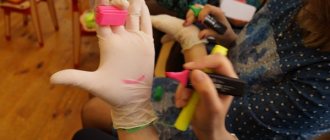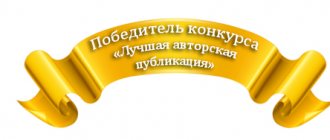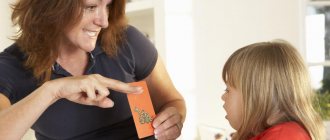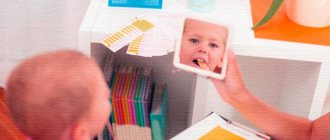that will make you Merry Poppins
The main feature of our games is that they were made by children's specialists who themselves work with children and understand the tasks of teachers.
I don't take my word for it
Click the button to open 10 free games.
Parents believe that the effectiveness of classes depends on the teacher. In practice, you can have the most advanced experience, carry out the most accurate diagnosis and work according to the best methods, but if the child does not try, your efforts are in vain.
The more the child is interested, the more effective the classes are.
We know how difficult it is to get a child to do what is needed. That's why we took the basic techniques you use to work with children and put the exercises into the format of interactive games. Games involve the child in the process, and he is happy to do what you need.
Why does this work?
If you spend a physical minute and ask your child to run in circles, he will quickly get bored. But if you give him a ball, set up a goal and call his friends, he will run until dinner.
If you are working on speech breathing and ask your child to blow on cotton wool, he will quickly get tired of it. But if you put a dragon in the field that blows flames and burns weeds when a child blows into the microphone, then he will blow into it as much as you need.
When a child is having fun and interesting with you, you are like Merry Poppins for him.
speech therapy games for Merry Poppins
After registration, you will have access to 10 games for developing speech and thinking, teaching counting, reading and other skills. Games with full functionality, constant access and no advertising.
Okay, the games interested the child. But how will this help me make the [P] sound?
The games consist of two parts: motivational and developmental. The child sees only the first: he breathes fire with a dragon, saves princesses with a knight, waters flowers with a butterfly. At the same time, the child develops speech breathing, automates sounds and activates the verbal dictionary.
The goal of each game is to solve a specific problem for the teacher. If a game doesn't solve a problem, we don't do it.
see for yourself
The games are designed for activities with children from 2 to 8 years old. They will be needed by speech therapists, defectologists, educators, psychologists, defectologists and other specialists.
Try the games
Register to see the quality of the games and play with your kids.
There are 10 games available in the demo version, they are not limited in time and functionality, and there are no advertisements. A limited version of “Picture Constructor 4” is also available, a program in which you can make a manual or methodological game for classes with children.
Register
To access other games, you need a subscription
Subscription gives access to:
- 287 interactive games for classes,
- the full version of “Picture Designer 4” for creating your own manuals and methodological games,
- a work office for maintaining documentation and a log of activities with children.
Buy a subscription
Subscription classes require internet access. If you don't have it, use flash drives or game discs. Go to the store
Tasks of ICT in speech therapy
Computer games in speech therapy are not only children's entertainment. They help solve a number of important problems:
- improvement of motor coordination and fine motor skills;
- spatial orientation training;
- speech correction;
- increasing vocabulary;
- training of HMF (higher mental functions);
- teaching a child to use a computer.
All of the listed tasks can be accomplished either using one game or by selecting several and alternating them. It is thanks to their versatility that speech simulators are becoming increasingly popular.
Elena Georgievna
speech therapist
I play in individual and subgroup lessons, I use it as part of the lesson, as encouragement at the end of the lesson. The children are delighted, try their best, and jump to class.
At my speech center there are children with various speech disorders. Games with a microphone are effective for correcting interdental sigmatism, for developing a smooth, long-lasting air stream and speech breathing. In the future, work is progressing well on developing the strength of the voice and the expressiveness of speech.
Children also love to come up with tasks with me in the Picture Constructor. I make mistakes (intentionally), and they correct me, arrange the pictures correctly and pronounce the sounds. And this is valuable, because you will never forget what you did correctly. Teachers joined me in working with the Picture Constructor.
Mersibo games are a lifesaver for a speech therapist, because they are multifunctional, entertaining and modern. It's so good that you exist. To the entire Mersibo team - health and success!
I play in individual and subgroup lessons, I use it as part of the lesson, as an encouragement at the end of the lesson. The children are delighted, trying their best...
Read completely
Computer games as a modern means of correcting speech disorders in preschool children
This article is an analysis of various sources on the description and application of computer technologies in the field of special education.
The article talks about the most well-known computer programs as an effective additional means of compensation in the process of correcting speech disorders in preschool children, and reveals the advantage of computer learning tools for children with disabilities over traditional means.
The article is intended for practicing teachers: speech therapists, defectologists, and will also be useful for beginning specialists and students of defectology departments.
An analysis of various literature shows that computer tools provide a specialist with an additional set of opportunities for correcting deviations in the development of a child.
A speech therapist who uses computer technology in his work needs to solve two main problems of special training:
- to develop children's ability to use a computer,
- apply computer technologies to correct speech disorders.
The use of NIT in domestic pedagogy is based on the basic psychological, pedagogical and methodological principles developed by L. S. Vygotsky, P. Ya. Galperin, V. V. Davydov, A. V. Zaporozhets, A. N. Leontyev, A. R. Luria, D. B. Elkonin and others.
Recently, there has been an increase in the number of children with various developmental disorders - these include speech pathologies, disorders of the musculoskeletal system, vision, hearing, and intelligence. The use of specialized computer technologies when working with them makes it possible to activate compensatory mechanisms and achieve optimal correction of impaired functions. Various developments are underway in this direction.
Thus, for people with musculoskeletal disorders, it is possible to change the configuration of the keyboard; a membrane keyboard with increased sensitivity and a keyboard with larger keys are used. Special finger sensors can be used.
For people with hearing impairments, special computer technologies have been developed in which the voice of a speaking person is converted into visual symbols on a monitor screen.
For people with visual impairments, a special keyboard with notches on the keys and programs are used to read out information - the so-called “Screen Reader” .
Attempts to visualize speech sounds have been made for quite some time. In the 70-80s in the former USSR, state funds were allocated for research and serial production of visual speech monitoring devices for the hearing impaired “VIR”, “I-2″, “VIR - 6 Intonograph” .
In 1987–89, the IBM Corporation introduced the desktop system “Visible Speech” based on a personal computer to the attention of professional speech therapists in the United States. In 1991, the first version of this program was Russified at the Institute of Correctional Pedagogy of the Russian Academy of Education. This program is primarily intended for working with both children and adult patients with impaired hearing (deaf and hard of hearing), but can be used in working with patients with intact physiological hearing.
This category includes children with primary speech pathology within the framework of dysarthria, dyslalia, alalia, rhinolalia and stuttering. The program is also effective when working with children with secondary speech disorders, whose main diagnosis is combined with speech pathology.
The first specialized product in Russia is the computer program “The World Outside Your Window” for older preschoolers and younger schoolchildren with hearing impairment, speech impairment, and mental retardation.
The program consists of five sections:
- "Four Seasons",
- "Weather",
- "Dress according to the weather"
- "Stories about the Season"
- "Calendar".
The use of this program in the process of frontal and individual work allows you to identify and overcome shortcomings in the development of mental operations, communicative, sign, and reading activities, and systematize your life experience in the field of seasonal phenomena.
“The World Outside Your Window” is currently used in special educational institutions, primary medical education institutions, and rehabilitation centers throughout the country.
Computer teaching technologies have also found their application in correcting the pronunciation side of speech in children with stuttering. For this purpose, a specialized computer program for speech development for stuttering “Demosthenes” . Work with the Demosthenes system is aimed at developing visual-kinesthetic and visual-auditory conditioned reflex connections in the central nervous system, allowing conscious control of the tempo, rhythm and emotional-intonation coloring of speech in communication situations. Visualization of speech components in this program is carried out in the form of pictures that open during speech, animated car movement, and an audiogram.
A special approach to the use of computer teaching aids in special education was applied in the development of the complex “Logotherapy Biofeedback Cabinet” (1998, “Biosvyaz”, St. Petersburg).
This technology combines therapeutic, health-improving and corrective effects on the child. The biofeedback room is designed for the prevention and correction of voice and speech disorders.
This technology can be used for stuttering, alalia, aphasia, dysgraphia and dyslexia, dyslalia, dysarthria, rhinolalia, phonation disorder due to paresis and paralysis of the larynx, functional dysphonia, speech tempo disorders, so-called speech anxiety, speech disorders in children and adults with hearing and vision.
The successful teaching of children to read, write and prevent dysgraphia is facilitated by the “virtual” school “Lessons of the Wise Owl” within the framework of Internet support (authors - speech therapists L. I. Kletnova, A. B. Larina). Thematic planning of lessons is structured according to the curriculum of the software and methodological complex for preparing children for studying in primary school “Learning with Logosha” . Thus, while studying the sound [A], children, together with Logosha, learn to identify it in stressed and unstressed positions, select words and pictures to match given patterns, and analyze the spelling of the letter A.
An information novelty, the training program “Dizartria.NET” was developed by the Center for Biocybernetics together with the UNESCO Institute of Information Technologies in Education.” This program is designed only to compensate for dysarthria, but not for stuttering. This program eliminates spasticity and insufficiency of speech motor centers.
Treatment includes:
- setting an antispastic pitch of the voice,
- setting voice timbre and voice frequency.
This program prosthetizes the speech circle between Broca's center and Wernicke's center. Only modified speech is used; the channel of direct speech perception is completely blocked using methodological techniques. Complete prosthetics of the speech circle causes: stabilization of the work of speech motor centers, an increase in the duration of exhalation by 2-3 times, elimination of speech breaks, suppression of the “fast” bone channel for the perception of one’s own speech, setting an antispastic pitch of the voice.
This technique of forced speech modification has been implemented and tested in speech therapy practice for a long time.
Demonstration presentations made in the Microsoft Power Point make it possible to get colorful, dynamic illustrations on the display screen for the material presented by the speech therapist, introduce children to an environment that corresponds to various lexical and grammatical topics, and introduce them to fairy-tale plots. One of the advantages of specialized computer tools is that they can significantly increase the motivational readiness of children to conduct correctional classes by simulating a correctional and developmental computer environment.
The specialized computer speech therapy program “Games for Tigers” allows you to work with children in the following areas:
- "Phonematics"
- "Prosodika"
- "Vocabulary",
- "Sound pronunciation".
The program is built on the basis of teaching methods for children with developmental disabilities by L. N. Efimenkova, G. A. Kashe, R. E. Levina, L. V. Lopatina, N. V. Serebryakova, R. I. Lalaeva, N. S. Zhukova, E.M. Mastyukova, T.B. Filicheva, G.V. Chirkina, as well as programs for education and training in kindergarten edited by M.A. Vasilyeva. It is addressed, first of all, to specialists - speech therapists and speech pathologists in preschool institutions.
The specialized computer speech therapy program “Sunny Castle” is a series of exercises aimed at correcting the phonetic and phonemic aspects of speech.
The program allows you to effectively work with children with various speech disorders.
The “Sunny Castle” program is designed to work with children of primary preschool age (3 - 4 years), middle preschool age (4 - 5), senior preschool age (5 - 6 years), and can be used when working with younger schoolchildren. Helps correct major speech disorders:
- phonemic hearing,
- formation of phonemic perception;
- reverse speech kinesthesia.
The speech therapy simulator “Delfa - 142” includes exercises aimed at correcting and improving all aspects of a student’s speech, including the simulator can be successfully used in a system of exercises for correcting written speech.
The speech therapy simulator "Delfa-142" is used in several areas of correctional work:
- correction of sound pronunciation, speech breathing and voice,
- formation of phonemic perception,
- literacy training,
- formation and correction of reading skills,
- formation of the lexical and grammatical aspects of speech.
The speech therapy computer game “Home Speech Therapist” is intended for working with children of senior preschool age (from 5 years old) and primary school age as a speech development aid, as well as for correctional and developmental work with children with speech disorders.
The program contains sections:
- "vowel sounds"
- "consonant sounds"
In addition, this program contains two fun mini-games - “Zvukovichok” and “Guessing Game” (growls, buzzers, puffs, rustles). These toys will help the baby develop non-speech (difference between household noises, sounds of nature, animals, etc.) and phonemic (difference between speech sounds) hearing.
Computer game “Speech development. “Learning to Speak Correctly” is an educational resource for individual and subgroup lessons on the development of phonemic awareness, tempo-rhythm, lexical-grammatical structure of speech and coherent speech.
Includes the following sections:
- Non-speech sounds
- Onomatopoeia
- Speech sounds
- Development of coherent speech
The section “Non-speech sounds” is presented by a video series consisting of a series of thematic and plot illustrations, and experimental tasks that can be used when studying lexical topics “Professions”, “Transport”, “Our Home”, “Winter”, “Spring”, “Summer” ", "Autumn".
A speech therapist teacher, using the illustrations presented, can carry out lexical work to clarify, expand and consolidate children’s vocabulary and grammatical structure of speech.
The “Speech Sounds” section is represented by multimedia task games of two types. The first type includes tasks “Hear the sound U”, “Hear the sound A”, etc. The second type of tasks includes the tasks “Determine the place of the sound U in the word”, “Place the pictures in the boxes. Sounds A, U”, “Place the pictures in the baskets. Sounds A, U, O”, “Game “Who is it?” What is this?”, “Count the sounds,” etc.
Thus, in modern speech therapy practice, computer speech therapy games are an effective means of correcting speech disorders. They are actively used both in individual work with children and with a group of children in the educational information technology classroom.
Bibliography:
- Akimenko M.V. Computer for kids. – M.: Major, 2005.
- Vishtynetsky, E. I., Krivosheev, A. O. Issues of information technologies in the field of education and training / E. I. Vishtynetsky, O. Krivosheev // Information technologies. – 1998. – No. 2.
- Gribova O. E. “Computer simulator “Delpha-142”. Practical guide. - M.: Delfa M, 2008.
- Zakharova I. G. “Information technologies in education”, M.: Publishing House, 2005.
- Lizunova L. R. Computer technology for correcting general speech underdevelopment “Games for Tigers”: Educational manual. – Perm: “FROM AND TO”, 2013.
- Repina Z. A., Lizunova L. R. Computer teaching aids: problems of development and implementation // Issues in the Humanities. 2004, no. 5.
- Shevchenko L. E., Astvatsaturov G. O., Software and methodological complex “Speech development. Let's learn to speak correctly." - M.: “New Disk”, 2008.
| Filonova N.V., speech therapist |
- Theatrical activities of preschool children as a means of correcting speech disorders
- Pedagogical project: Using fairy tales as a method of correcting speech disorders in older preschoolers
- Music therapy in the correction of speech disorders in preschool children
- Fairy tales as a means of developing coherent speech in preschoolers with general speech underdevelopment
- Developmental technologies in the correction of speech disorders in older preschoolers
( 3 liked, average score: 5.00 out of 5)
Loading...




